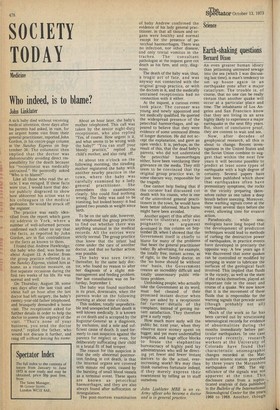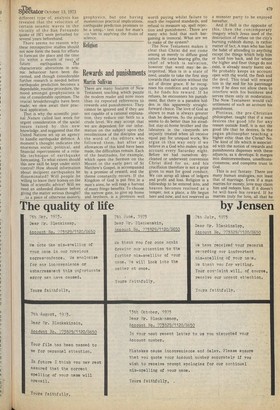Science
Earth-shaking questions
Bernard Dixon
An even greater human idiocy than jettisoning untreated sewage into the sea (which I was discussing last time), is man's tendency to set up house again in an earthquake zone after a major cataclysm. The trouble is, of course, that no one can be really certain that another quake will occur at a particular place and time. The inhabitants of Los Angeles and San Francisco know that they are living in an area highly likely to experience a major earthquake in the next fifty years. But, short of conclusive proof, they are content to wait and see.
Now, after decades of geophysical research, all this is about to change. Recent investigations in the United States and the Soviet Union combine to suggest that within the next few years it will become possible to ' predict at least some types of earthquake with a high degree of certainty. Several papers have just been published which show that earthquakes often have premonitory symptoms, the rocks in the vicinity preparing themselves rather as one takes a deep breath before sneezing. Moreover, these warning signals come at the very least several days before -the event, allowing time for evasive action.
Paradoxically, while seismologists have long hoped that the development of prediction techniques would lead to methods of curbing the destructive power of earthquakes, in practice events have developed in precisely the opposite way. A few years ago it was discovered that some quakes can be controlled or modified by pumping in water to lubricate the surfaces of the geological fault involved. This implied that fluids in the vicinity, as well as the state of the rocks themselves, played an important role in the onset and course of a quake. We now know that it is the movement of these fluids that is responsible for the warning signals that precede some (though probably not all) earthquakes.
Much of the work so far has been carried out by scrutinising seismological records for evidence of abnormalities' during the months immediately before par ticular earthquakes. In one case reported recently, research workers at the University of Colorado have found that characteristic seismographic changes recorded at the Mat sushiro seismic station preceded
by three years the Matsushiro earthquakes of 1965. The sig
nificance of the signals was not
apparent at the time. This disclosure came from a sophis
ticated analysis of data published in the Bulletin of the International Seismological Center for the years 1960 to 1968. Another, though different type of, analysis has revealed that the velocities of certain seismic waves in the vicinity of the San Fernando quake of 1971 were perturbed for several years beforehand.
There seems no reason why these retrospective studies should not now form the basis for efforts to forecast the place and the time (to within a month of two) of future earthquakes. The characteristic alterations in seismic behaviour have been dis cerned, and though considerable further research is needed before earthquake prediction becomes a dependable, routine procedure, the mood amongst geophysicists is one of considerable optimism. The crucial breakthroughs have, been made; we 1111)w await their practical application.
That is why the scientific journal Nature called last week for urgent consideration of the social issues raised by this new knowledge, and suggested that the United Nations set up an agency to handle earthquake defence. A moment's thought indicates the enormous social, political, and financial repercussions of a reliable technique of earthquake forecasting. To what extent should this new skill be kept under strict control? How should information about incipient earthquakes be disseminated? Will people be willing to leave their homes on the basis of scientific advice? Will we need an unheeded disaster before' giving the matter serious thought? As a piece of otherwise esoteric
geophysics, but one having momentous practical implications, earthquake prediction promises to be a uniqu, test case for man's ,vis 'om in applying the fruits of science.



































 Previous page
Previous page